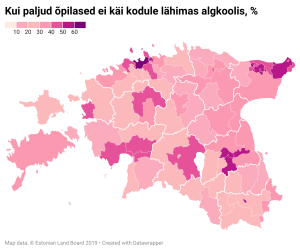The analysis of the Foresight Centre shows that increasing the revenues of Estonian municipalities would improve the quality and availability of public services. However, the annual growth of revenues is not enough for this. It is necessary to find extra income, carry out fundamental innovative changes, or reduce the responsibilities of the municipalities.
News
The Foresight Centre notes in its newly published yearbook that better targeted preventive services would help to control the social costs that come with the aging population. However, more efficient use of people’s data requires legal clarity regarding the permissibility of data use.
Nearly half of the students in Estonia do not attend the primary school closest to their home and almost 60% do not go to the upper secondary school of their residence. According to the short report ‘Estonian Internal Educational Migration in General Education’ by the Foresight Centre, large-scale domestic educational migration indicates that many families are looking for higher quality education and reject the schools closest to their home.
A recent short report by the Foresight Centre shows that in the coming years, there will be an increasing need to involve foreign workforce in the Estonian healthcare system. Also, the proportion of healthcare workers who work in the private sector and in multiple jobs keeps growing, which in turn reduces the national healthcare system’s capacity and increases patient waiting times.
This year, the Foresight Centre researches the accessibility of local services. For this, the spatial data is analysed in order to assess the distance of the most essential services from people’s homes. The efficiency of municipalities is also analysed in order to get an overview of how effectively the available resources are used.
In Estonia, hobby education is more accessible to children of more educated and wealthier parents and mainly in Harju, Tartu and Pärnu counties. Ensuring the accessibility of hobby education for children with special educational needs and more difficult socioeconomic backgrounds is a major challenge according to the Foresight Centre’s short report ‘Accessibility of hobby education in Estonia’.
Nowadays our generation is getting a bigger say in the decision-making processes. From voting to media access, we are witnessing drastic changes in youth empowerment. Currently, more and more young people are receiving the opportunity to engage in civic activities that are leading to innovation. This all leads to the fact that some of the populist far-right parties in Europe are taking advantage of it, writes Oleksii Shpak, a young Ukrainian, who studies political science at Tallinn University.
After the administrative reform, the differences in the revenues of the so-called wealthy and poor municipalities decreased and the income per resident significantly increased. Today, however, the gap between municipalities is widening again, according to the Foresight Centre’s short report ‘Trends in local government revenues’.
The Foresight Centre conference ‘The personalised state in Estonia: future directions, risks and opportunities’ discussed the opportunities of personalisation of state services and benefits and focused on risks involved in using people’s data.
A report from the Foresight Centre shows that half of Estonian residents support linking benefits to income. Need-based benefits are more favoured by older people and those with lower income, while younger age groups and parents of minor children are less supportive of them.

 An independent think tank at the Riigikogu
An independent think tank at the Riigikogu 








